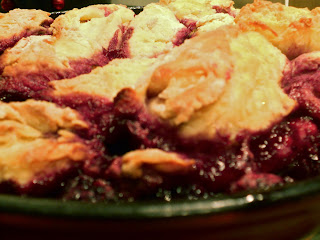This is my first recipe from Good Eats 2: The Middle Years. The episode this recipe is from is all about cobblers and there many varieties. Ever wonder what the difference is between a sonker and a brown Betty? Probably not, but I'm going to tell you anyways. Lets start with some definitions, a key to cobbler classification if you will:
 Cobbler - a fruit dessert made with some kind of dough be it biscuit like or pie like dough. The origin of the name has two possible roots, one being that the cooked dough often resembles the unevenness of cobblestone streets and the second being that the ingredients are just "cobbled" together.
Cobbler - a fruit dessert made with some kind of dough be it biscuit like or pie like dough. The origin of the name has two possible roots, one being that the cooked dough often resembles the unevenness of cobblestone streets and the second being that the ingredients are just "cobbled" together.The many subclasses of cobbler:
Brown Betty - fruit layered with buttered bread crumbs and baked
Buckle - a generic cake batter with fruit stirred into it. The cake batter "buckles" under the weight of the fruit during cooking
Crisp (crumble in England) - fruit baked with a topping of sugar, butter, flour and oats or nuts
Pandowny - the dough is pressed down into fruit and then baked
Sonker - high fruit to dough ratio, from a small area in North Carolina
and last but not least...
Grunt - fruit cooked on the stove top with biscuit dough creating dumplings. Named for the sound it makes when cooking
I must give credit to Alton Brown for all of this culinary insight.
With all that out of the way down to business, the blackberry grunt. I am a big fan of this recipe although there area few tweaks that could make a little better in my opinion. I had never cooked with blackberries before and although they were tasty I would have preferred a more familiar fruit like blueberries or strawberries. I was going to use blueberries but as luck would have it blackberries were on sale this week! The dumplings were delicious, soft and sweet from the fruits' juices. The recipe broke from tradition and put the grunt in the oven to brown the tops of the dumplings. Next time I think I would stick to tradition and just put a lid on it and let it cook on the stovetop. This would produce a soft dumpling all the way through instead of dumplings that are soft on the bottom and golden brown on top. To each there own.
Recipe link: http://www.foodnetwork.com/recipes/alton-brown/blackberry-grunt-recipe/index.html










